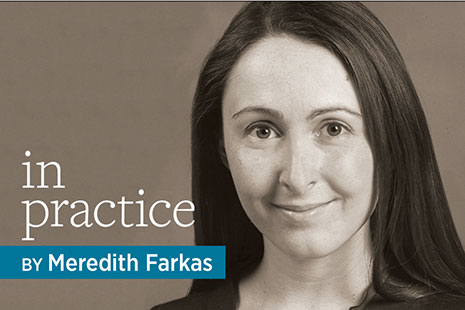
My library works with our college’s Disability Services office to test any web-based platform we are considering for compliance with the Americans with Disabilities Act (ADA). When I recently advocated for us to subscribe to a new database, I was invited to meet with a visually impaired Disability Services employee to test the platform.
I’d been aware of screen readers, which read what is on a computer screen to a visually impaired user, but this was the first time I’d actually seen one in action. While the platform we were testing was deemed accessible because it was compatible with screen readers and its videos contained closed captions, multiple design features made the platform far less convenient for a visually impaired person to use. The long, exploded-by-default menus meant that visually impaired students had to listen to the computer read each navigation option to them before they got to the content they wanted. Search boxes, too, were often buried beneath navigational elements, which cost time for the user.
This experience got me thinking a lot more about how users with disabilities encounter our web content and how we can not only make it accessible, but also make it more usable for them. Universal design combines accessibility and usability practices to create a positive online experience for every user. It supports the idea of adaptability in design to meet users’ unique needs.
Accessibility isn’t just a nice thing to do—it’s a legal requirement. Several colleges have been subject to lawsuits from the National Federation of the Blind in recent years for requiring the use of technologies that were inaccessible. In 2012, the federation filed suit against the Free Library of Philadelphia for its circulating Nook e-reader program because the devices were not ADA-compliant. Not doing our homework to investigate accessibility when designing our web services, subscribing to a new database, or adopting a new technology can be a costly mistake.
A decade ago, most of a library’s online content was controlled by a small number of people, most of whom had training in web design, including standard practices for accessibility. The growth of content management systems and tools like LibGuides have led to more distributed responsibility for the development and maintenance of library web content. Many librarians who are creating web content are unaware of simple things they could do to make their content more accessible, such as adding alternative text descriptions for images and making sure the title attributes of links are clearly described. This list has more great tips.
Libraries are creating not only web pages but also video content. When we create video tutorials, we should always caption them. YouTube makes it easy to upload a transcript, and it automatically sets the timing along with the narration. If you don’t have a script, you can easily go through and edit YouTube’s flawed automatic captioning. I have seen so many terrific information literacy video tutorials created by other libraries that I’ve wanted to incorporate into my teaching and research guides, but I’ve been stopped by their lack of captioning.
When we consider how much of our web content comes from outside vendors, we may feel like we don’t have much control over our users’ experience. That is simply not true. My library has chosen not to subscribe to certain platforms because they were not ADA-accessible and the vendor had no plans to change that. The problem is that vendors will not be motivated to make their content accessible unless more libraries follow suit. In the end, it is not the vendor who will be sued if content isn’t accessible; it’s our organizations. By using our buying power to pressure vendors to make their content and platforms accessible, we protect our parent institutions from risk and ensure a good experience for all of our users.


